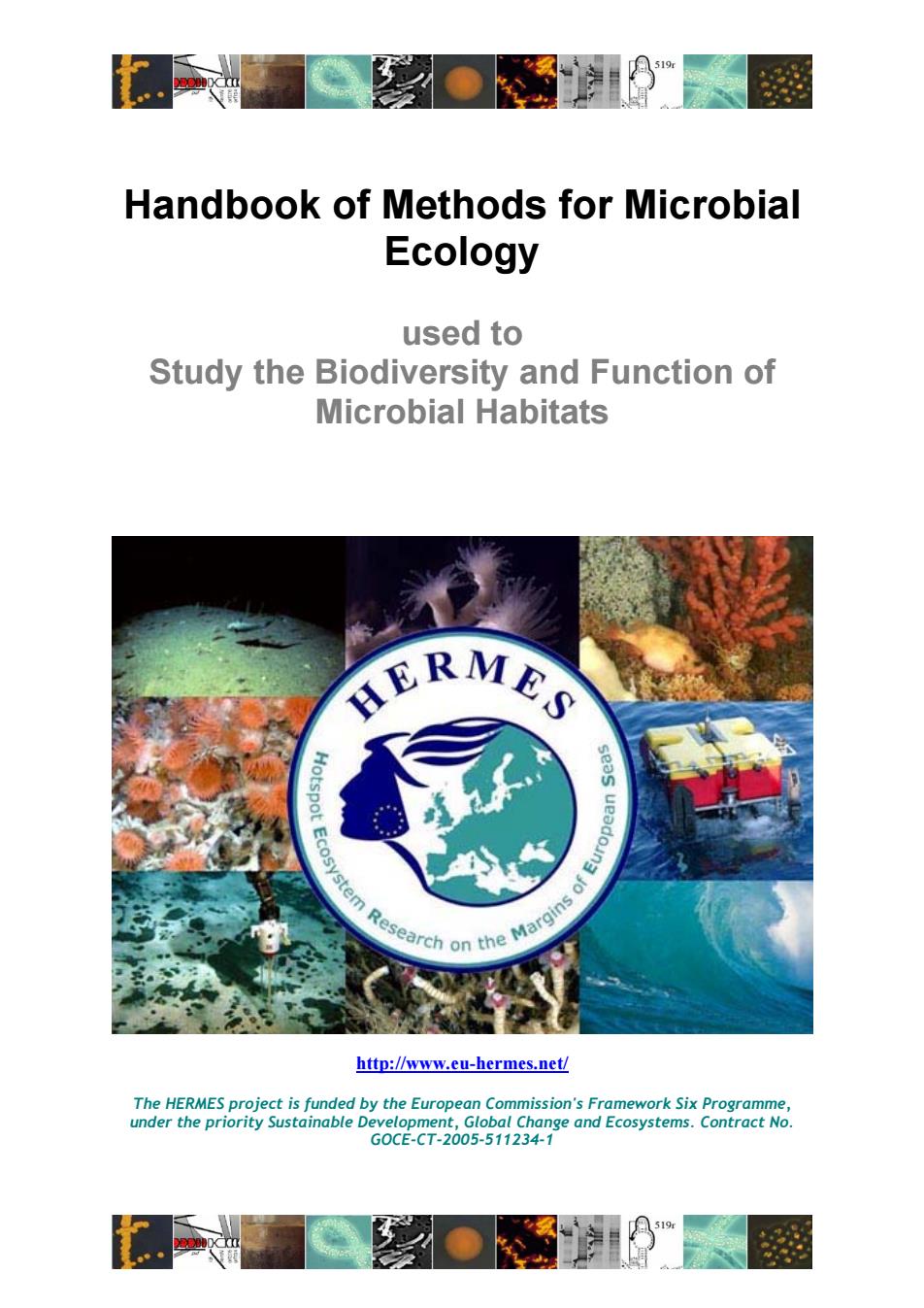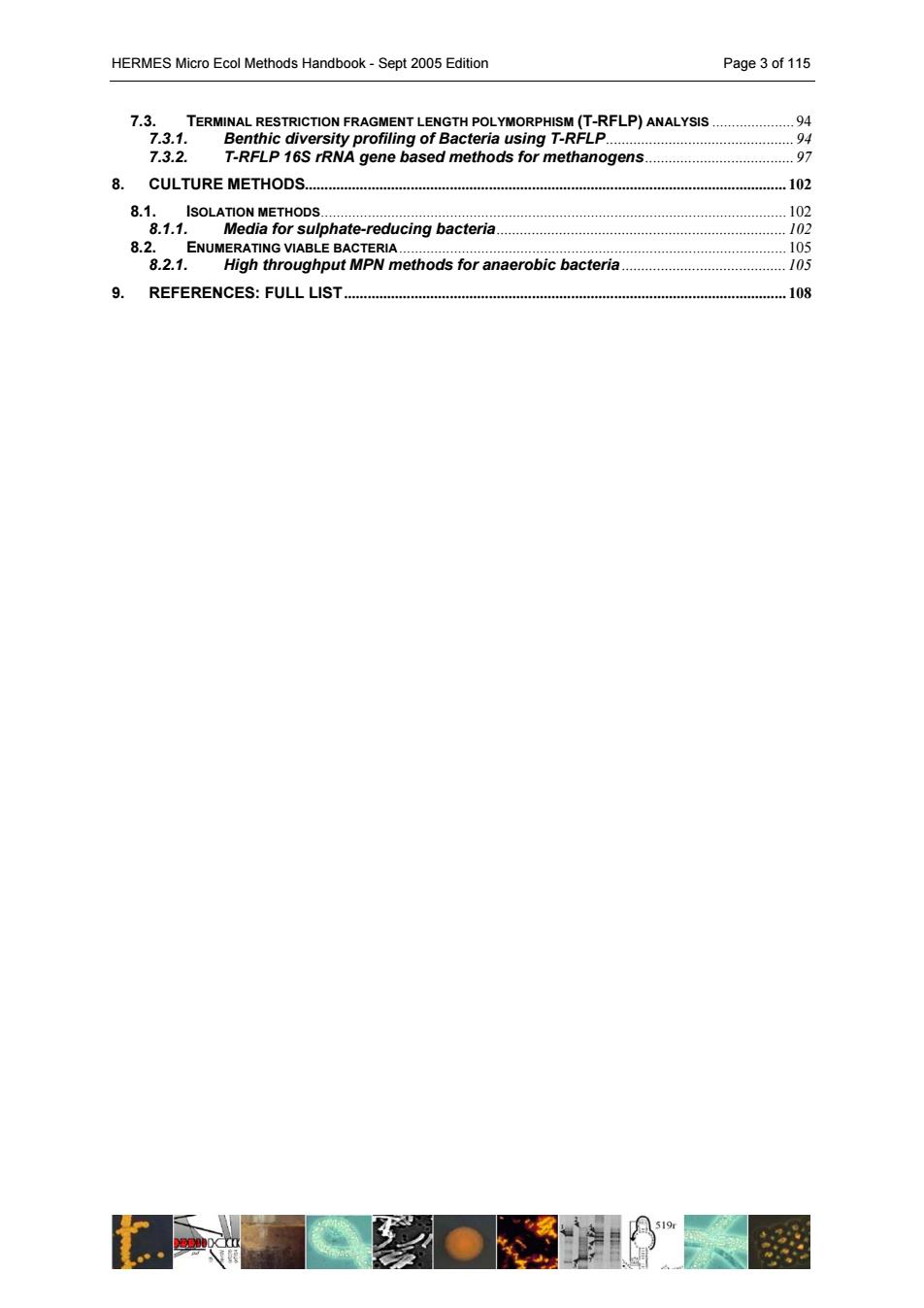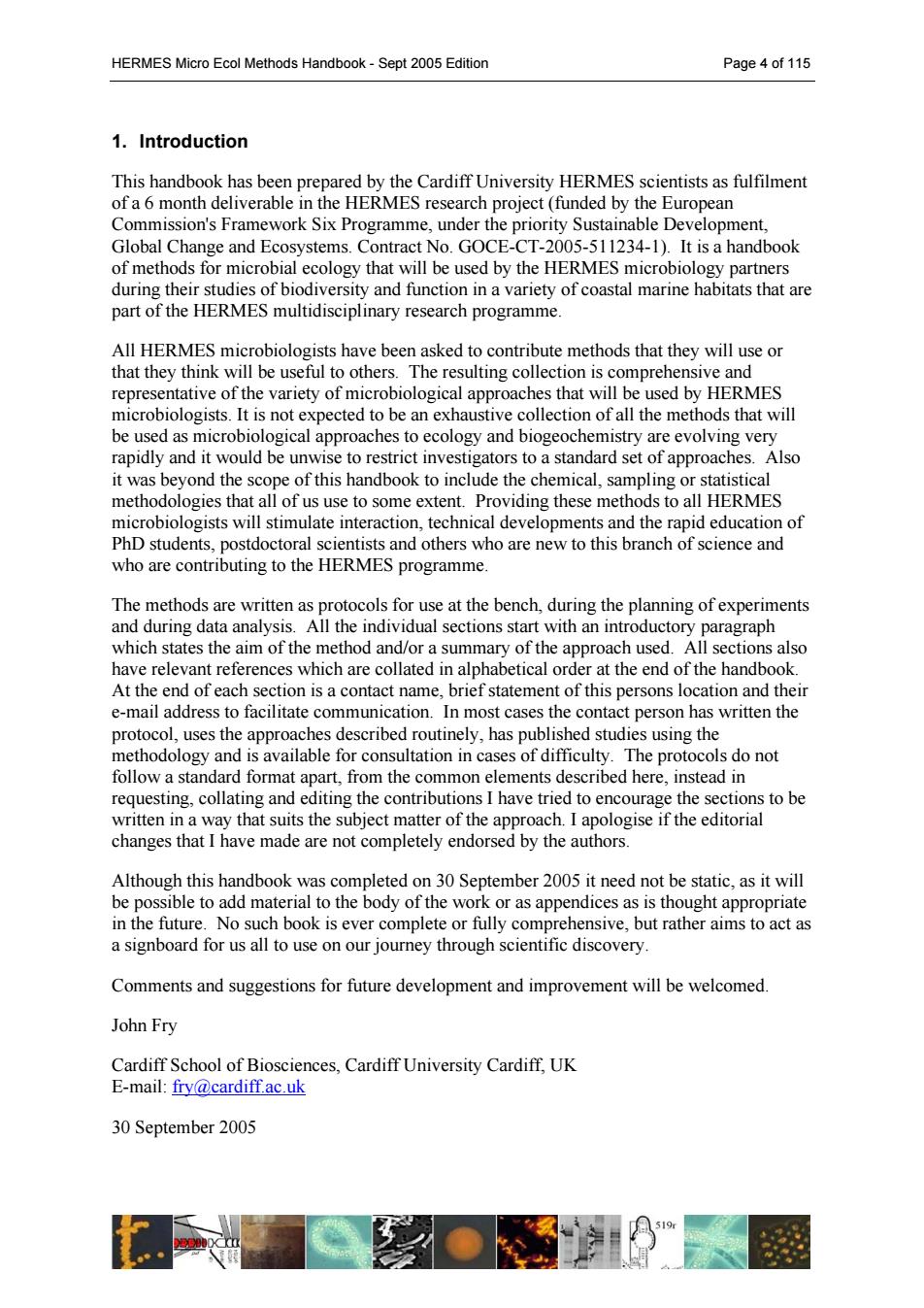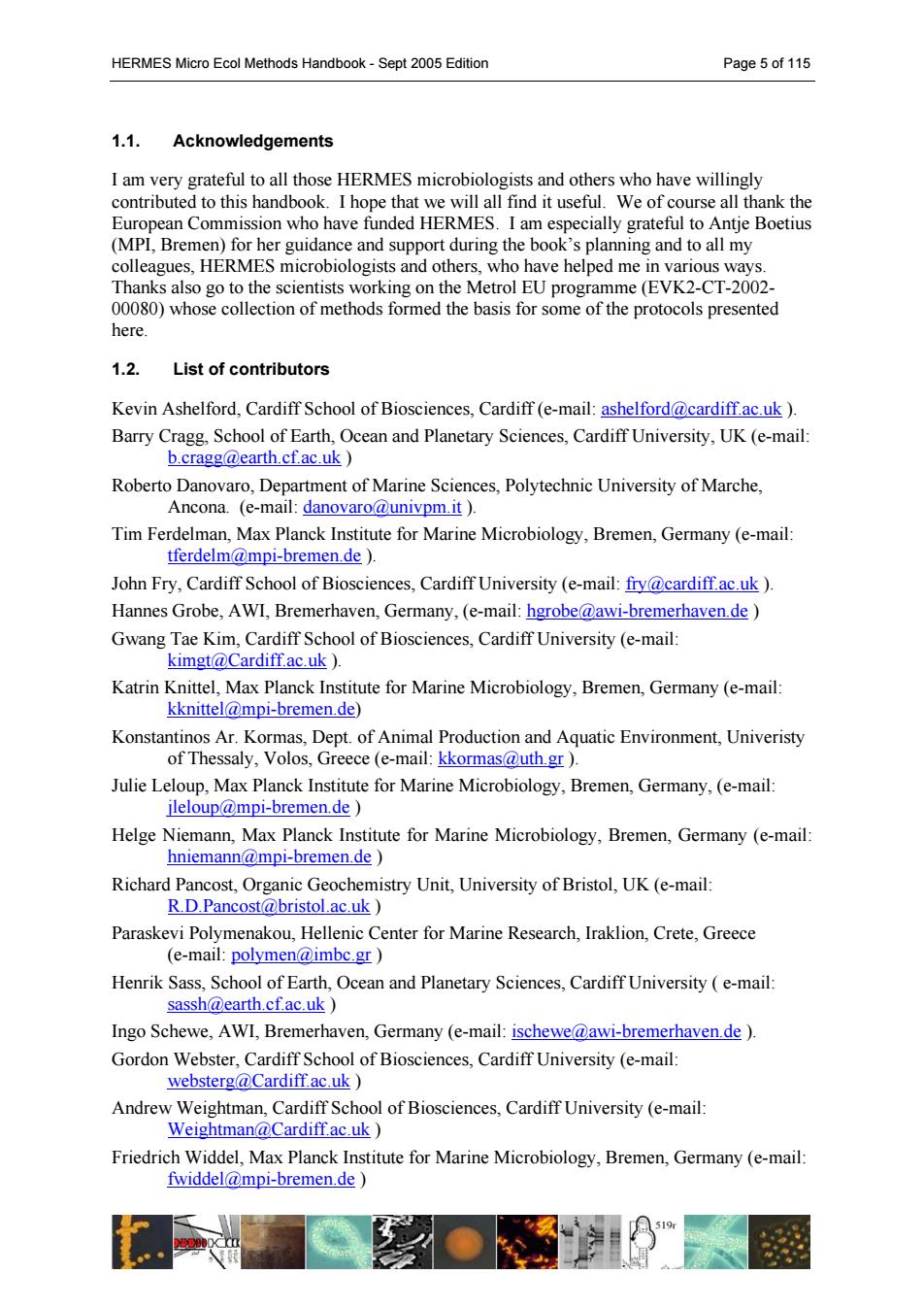
519 Handbook of Methods for Microbial Ecology used to Study the Biodiversity and Function of Microbial Habitats HERMES spotem Research on the http://www.eu-hermes.net/ The HERMES project is funded by the European Commission's Framework Six Programme, under the priority Sustainable Development,Global Change and Ecosystems.Contract No G0CE-CT-2005-511234-1 519
Handbook of Methods for Microbial Ecology used to Study the Biodiversity and Function of Microbial Habitats http://www.eu-hermes.net/ The HERMES project is funded by the European Commission's Framework Six Programme, under the priority Sustainable Development, Global Change and Ecosystems. Contract No. GOCE-CT-2005-511234-1

HERMES Micro Ecol Methods Handbook-Sept 2005 Edition Page 2 of 115 Contents INTRODUCTION............... 1.1. ACKNOWLEDGEMENTS. 1.2. LIST OF CONTRIBUTORS 2.SAMPLE IDENTIFICATION DATA MANAGEMENT FOR MICROBIOLOGY SAMPLES........6 3.RATE AND ACTIVITY MEASUREMENTS.....8 3.1. THYMIDINE INCORPORATION 8 3.2 LEUCINE INCORPORATION........... ..11 3.3. SULPHATE REDUCTION...... 13 3.4. METHANOGENESIS FROM CO2+H2 AND FROM ACETATE .16 3.5. ANAEROBIC OXIDATION OF METHANE........ 18 3.6. IN VITRO SULPHATE REDUCTION WITH METHANE..... 21 3.6.1. In vitro rate determination from substrate concentration changes 2 3.6.2. In vitro rate determination from radio-labelled tracer turnover.............2.4 3.7. ASSESSMENT OF EXTRACELLULAR ENZYMATIC ACTIVITIES OF BENTHIC ASSEMBLAGES 25 4.COUNTING METHODS 27 4.1. ACRIDINE ORANGE DIRECT COUNTING(AODC)OF PROKARYOTIC CELLS IN SEDIMENT...............27 4.2 FLUoRESCENT IN SITU HYBRIDIZATION (FISH)29 4.3 CARD-FISH...... .32 5.BIOMASS AND BIOMARKER METHODS............................................................36 5.1. PHOPSPHOLIPIDS FOR BIOMASS ESTIMATION 36 5.2. PROTEIN FOR BIOMASS ESTIMATION. 38 5.3. PHOSPHOLIPID/BIOMARKER ANALYSIS..... …41 6. MOLECULAR METHODS FOR INVESTIGATING DIVERSITY:CLONE LIBRARIES .45 6.1. DNA EXTRACTION FROM SEDIMENTS..... .45 6.1.1. Modified Zhou et al (1996)method............. ……45 6.1.2. Modified FastDNA Spin kit(Q-BIO gene)DNA extraction method and tips for subsequent molecular diversity studies in low DNA sediments.............. .48 6.2. PCR… 6.3 SELECTING AND CONFIRMING EFFICACY OF 16S RRNA GENE PRIMERS.. 51 53 6.4. SELECTING AND USING PRIMERS FOR FUNCTIONAL GENES...5.6 6.4.1. Methyl coenzyme M reductase(mcrA)genes for methanogens...... 56 6.4.2 Quantitative Real-time PCR of the dsrAB genes from sulphate-reducers..........59 6.4.3. Other functional genes and small subunit rRNA groups.61 6.5. CLONING,CLONE SELECTION AND SEQUENCING...... .64 6.5.1. Contribution 64 6.5.2 Contribution 2........... 67 6.6. SCREENING CLONE LIBRARIES FOR ARTEFACTS,CHIMERAS AND COVERAGE 70 6.7 PHYLOGENETIC ANALYSES....... .79 7.MOLECULAR METHODS FOR INVESTIGATING DIVERSITY:PROFILING METHODS..........85 7.1. DENATURING GRADIENT GEL ELECTROPHORESIS(DGGE)FOR 16S RRNA GENES ..............85 7.1.1. Sequencing bands from DGGEgels8 7.1.2 Analysis of DGGE profile data................ .88 7.2. BENTHIC DIVERSITY PROFILING OF BACTERIA USING ARISA 92
HERMES Micro Ecol Methods Handbook - Sept 2005 Edition Page 2 of 115 Contents 1. INTRODUCTION........................................................................................................................................4 1.1. ACKNOWLEDGEMENTS........................................................................................................................5 1.2. LIST OF CONTRIBUTORS......................................................................................................................5 2. SAMPLE IDENTIFICATION & DATA MANAGEMENT FOR MICROBIOLOGY SAMPLES.........6 3. RATE AND ACTIVITY MEASUREMENTS............................................................................................8 3.1. THYMIDINE INCORPORATION ...............................................................................................................8 3.2. LEUCINE INCORPORATION.................................................................................................................11 3.3. SULPHATE REDUCTION......................................................................................................................13 3.4. METHANOGENESIS FROM CO2 + H2 AND FROM ACETATE ...............................................................16 3.5. ANAEROBIC OXIDATION OF METHANE...............................................................................................18 3.6. IN VITRO SULPHATE REDUCTION WITH METHANE..............................................................................21 3.6.1. In vitro rate determination from substrate concentration changes.......................21 3.6.2. In vitro rate determination from radio-labelled tracer turnover..............................24 3.7. ASSESSMENT OF EXTRACELLULAR ENZYMATIC ACTIVITIES OF BENTHIC ASSEMBLAGES ...............25 4. COUNTING METHODS ..........................................................................................................................27 4.1. ACRIDINE ORANGE DIRECT COUNTING (AODC) OF PROKARYOTIC CELLS IN SEDIMENT ................27 4.2. FLUORESCENT IN SITU HYBRIDIZATION (FISH) ...............................................................................29 4.3. CARD-FISH.....................................................................................................................................32 5. BIOMASS AND BIOMARKER METHODS..........................................................................................36 5.1. PHOPSPHOLIPIDS FOR BIOMASS ESTIMATION ..................................................................................36 5.2. PROTEIN FOR BIOMASS ESTIMATION.................................................................................................38 5.3. PHOSPHOLIPID/BIOMARKER ANALYSIS.............................................................................................41 6. MOLECULAR METHODS FOR INVESTIGATING DIVERSITY: CLONE LIBRARIES................45 6.1. DNA EXTRACTION FROM SEDIMENTS ...............................................................................................45 6.1.1. Modified Zhou et al (1996) method .................................................................................45 6.1.2. Modified FastDNA® Spin kit (Q-BIO gene) DNA extraction method and tips for subsequent molecular diversity studies in low DNA sediments...............................................48 6.2. PCR...................................................................................................................................................51 6.3. SELECTING AND CONFIRMING EFFICACY OF 16S RRNA GENE PRIMERS ........................................53 6.4. SELECTING AND USING PRIMERS FOR FUNCTIONAL GENES .............................................................56 6.4.1. Methyl coenzyme M reductase (mcrA) genes for methanogens.............................56 6.4.2. Quantitative Real-time PCR of the dsrAB genes from sulphate-reducers...........59 6.4.3. Other functional genes and small subunit rRNA groups..........................................61 6.5. CLONING, CLONE SELECTION AND SEQUENCING..............................................................................64 6.5.1. Contribution 1 ......................................................................................................................64 6.5.2. Contribution 2 ......................................................................................................................67 6.6. SCREENING CLONE LIBRARIES FOR ARTEFACTS, CHIMERAS AND COVERAGE ................................70 6.7. PHYLOGENETIC ANALYSES ...............................................................................................................79 7. MOLECULAR METHODS FOR INVESTIGATING DIVERSITY: PROFILING METHODS..........85 7.1. DENATURING GRADIENT GEL ELECTROPHORESIS (DGGE) FOR 16S RRNA GENES .....................85 7.1.1. Sequencing bands from DGGE gels ..............................................................................87 7.1.2. Analysis of DGGE profile data.........................................................................................88 7.2. BENTHIC DIVERSITY PROFILING OF BACTERIA USING ARISA.........................................................92

HERMES Micro Ecol Methods Handbook-Sept 2005 Edition Page 3 of 115 7.3.TERMINAL RESTRICTION FRAGMENT LENGTH POLYMORPHISM(T-RFLP)ANALYSIS 94 7.3.1. Benthic diversity profiling of Bacteria using T-RFLP.....................94 7.3.2 T-RFLP 16S rRNA gene based methods for methanogens. 97 8. CULTURE METHODS........ 102 8.1.ISOLATION METHODS..... 102 8.1.1.Media for sulphate-reducing bacteria...... 102 8.2.ENUMERATING VIABLE BACTERIA........... 105 8.2.1.High throughput MPN methods for anaerobic bacteria............................... 05 9.REFERENCES:FULL LIST........ .108 ●
HERMES Micro Ecol Methods Handbook - Sept 2005 Edition Page 3 of 115 7.3. TERMINAL RESTRICTION FRAGMENT LENGTH POLYMORPHISM (T-RFLP) ANALYSIS .....................94 7.3.1. Benthic diversity profiling of Bacteria using T-RFLP................................................94 7.3.2. T-RFLP 16S rRNA gene based methods for methanogens......................................97 8. CULTURE METHODS...........................................................................................................................102 8.1. ISOLATION METHODS.......................................................................................................................102 8.1.1. Media for sulphate-reducing bacteria..........................................................................102 8.2. ENUMERATING VIABLE BACTERIA...................................................................................................105 8.2.1. High throughput MPN methods for anaerobic bacteria ..........................................105 9. REFERENCES: FULL LIST.................................................................................................................108

HERMES Micro Ecol Methods Handbook-Sept 2005 Edition Page 4 of 115 1.Introduction This handbook has been prepared by the Cardiff University HERMES scientists as fulfilment of a 6 month deliverable in the HERMES research project(funded by the European Commission's Framework Six Programme,under the priority Sustainable Development. Global Change and Ecosystems.Contract No.GOCE-CT-2005-511234-1).It is a handbook of methods for microbial ecology that will be used by the HERMES microbiology partners during their studies of biodiversity and function in a variety of coastal marine habitats that are part of the HERMES multidisciplinary research programme. All HERMES microbiologists have been asked to contribute methods that they will use or that they think will be useful to others.The resulting collection is comprehensive and representative of the variety of microbiological approaches that will be used by HERMES microbiologists.It is not expected to be an exhaustive collection of all the methods that will be used as microbiological approaches to ecology and biogeochemistry are evolving very rapidly and it would be unwise to restrict investigators to a standard set of approaches.Also it was beyond the scope of this handbook to include the chemical,sampling or statistical methodologies that all of us use to some extent.Providing these methods to all HERMES microbiologists will stimulate interaction,technical developments and the rapid education of PhD students,postdoctoral scientists and others who are new to this branch of science and who are contributing to the HERMES programme. The methods are written as protocols for use at the bench,during the planning of experiments and during data analysis.All the individual sections start with an introductory paragraph which states the aim of the method and/or a summary of the approach used.All sections also have relevant references which are collated in alphabetical order at the end of the handbook. At the end of each section is a contact name,brief statement of this persons location and their e-mail address to facilitate communication.In most cases the contact person has written the protocol,uses the approaches described routinely,has published studies using the methodology and is available for consultation in cases of difficulty.The protocols do not follow a standard format apart,from the common elements described here,instead in requesting,collating and editing the contributions I have tried to encourage the sections to be written in a way that suits the subject matter of the approach.I apologise if the editorial changes that I have made are not completely endorsed by the authors. Although this handbook was completed on 30 September 2005 it need not be static,as it will be possible to add material to the body of the work or as appendices as is thought appropriate in the future.No such book is ever complete or fully comprehensive,but rather aims to act as a signboard for us all to use on our journey through scientific discovery. Comments and suggestions for future development and improvement will be welcomed. John Fry Cardiff School of Biosciences,Cardiff University Cardiff,UK E-mail:fry@cardiff.ac.uk 30 September 2005
HERMES Micro Ecol Methods Handbook - Sept 2005 Edition Page 4 of 115 1. Introduction This handbook has been prepared by the Cardiff University HERMES scientists as fulfilment of a 6 month deliverable in the HERMES research project (funded by the European Commission's Framework Six Programme, under the priority Sustainable Development, Global Change and Ecosystems. Contract No. GOCE-CT-2005-511234-1). It is a handbook of methods for microbial ecology that will be used by the HERMES microbiology partners during their studies of biodiversity and function in a variety of coastal marine habitats that are part of the HERMES multidisciplinary research programme. All HERMES microbiologists have been asked to contribute methods that they will use or that they think will be useful to others. The resulting collection is comprehensive and representative of the variety of microbiological approaches that will be used by HERMES microbiologists. It is not expected to be an exhaustive collection of all the methods that will be used as microbiological approaches to ecology and biogeochemistry are evolving very rapidly and it would be unwise to restrict investigators to a standard set of approaches. Also it was beyond the scope of this handbook to include the chemical, sampling or statistical methodologies that all of us use to some extent. Providing these methods to all HERMES microbiologists will stimulate interaction, technical developments and the rapid education of PhD students, postdoctoral scientists and others who are new to this branch of science and who are contributing to the HERMES programme. The methods are written as protocols for use at the bench, during the planning of experiments and during data analysis. All the individual sections start with an introductory paragraph which states the aim of the method and/or a summary of the approach used. All sections also have relevant references which are collated in alphabetical order at the end of the handbook. At the end of each section is a contact name, brief statement of this persons location and their e-mail address to facilitate communication. In most cases the contact person has written the protocol, uses the approaches described routinely, has published studies using the methodology and is available for consultation in cases of difficulty. The protocols do not follow a standard format apart, from the common elements described here, instead in requesting, collating and editing the contributions I have tried to encourage the sections to be written in a way that suits the subject matter of the approach. I apologise if the editorial changes that I have made are not completely endorsed by the authors. Although this handbook was completed on 30 September 2005 it need not be static, as it will be possible to add material to the body of the work or as appendices as is thought appropriate in the future. No such book is ever complete or fully comprehensive, but rather aims to act as a signboard for us all to use on our journey through scientific discovery. Comments and suggestions for future development and improvement will be welcomed. John Fry Cardiff School of Biosciences, Cardiff University Cardiff, UK E-mail: fry@cardiff.ac.uk 30 September 2005

HERMES Micro Ecol Methods Handbook-Sept 2005 Edition Page 5 of 115 1.1. Acknowledgements I am very grateful to all those HERMES microbiologists and others who have willingly contributed to this handbook.I hope that we will all find it useful.We of course all thank the European Commission who have funded HERMES.I am especially grateful to Antje Boetius (MPL,Bremen)for her guidance and support during the book's planning and to all my colleagues,HERMES microbiologists and others,who have helped me in various ways. Thanks also go to the scientists working on the Metrol EU programme(EVK2-CT-2002- 00080)whose collection of methods formed the basis for some of the protocols presented here 1.2. List of contributors Kevin Ashelford,Cardiff School of Biosciences,Cardiff(e-mail:ashelford@cardiff.ac.uk ) Barry Cragg,School of Earth,Ocean and Planetary Sciences,Cardiff University,UK (e-mail: b.cragg@earth.cf.ac.uk Roberto Danovaro,Department of Marine Sciences,Polytechnic University of Marche, Ancona.(e-mail:danovaro@univpm.it ) Tim Ferdelman,Max Planck Institute for Marine Microbiology,Bremen,Germany (e-mail: tferdelm @mpi-bremen.de ) John Fry,Cardiff School of Biosciences,Cardiff University (e-mail:fry@cardiff.ac.uk ) Hannes Grobe,AWI,Bremerhaven,Germany,(e-mail:hgrobe@awi-bremerhaven.de Gwang Tae Kim,Cardiff School of Biosciences,Cardiff University (e-mail: kimgt@Cardiff.ac.uk ) Katrin Knittel,Max Planck Institute for Marine Microbiology,Bremen,Germany (e-mail: kknittel@mpi-bremen.de) Konstantinos Ar.Kormas,Dept.of Animal Production and Aquatic Environment,Univeristy of Thessaly,Volos,Greece (e-mail:kkormas@uth.gr ) Julie Leloup,Max Planck Institute for Marine Microbiology,Bremen,Germany,(e-mail: jleloup@mpi-bremen.de Helge Niemann,Max Planck Institute for Marine Microbiology,Bremen,Germany (e-mail: hniemann@mpi-bremen.de Richard Pancost,Organic Geochemistry Unit,University of Bristol,UK(e-mail: R.D.Pancost@bristol.ac.uk Paraskevi Polymenakou,Hellenic Center for Marine Research,Iraklion,Crete,Greece (e-mail:polymen@imbc.gr Henrik Sass,School of Earth,Ocean and Planetary Sciences,Cardiff University (e-mail: sassh@earth.cf.ac.uk Ingo Schewe,AWI,Bremerhaven,Germany (e-mail:ischewe@awi-bremerhaven.de ) Gordon Webster,Cardiff School of Biosciences,Cardiff University (e-mail: websterg@Cardiff.ac.uk Andrew Weightman,Cardiff School of Biosciences,Cardiff University (e-mail: Weightman@Cardiff.ac.uk Friedrich Widdel,Max Planck Institute for Marine Microbiology,Bremen,Germany(e-mail: fwiddel@mpi-bremen.de
HERMES Micro Ecol Methods Handbook - Sept 2005 Edition Page 5 of 115 1.1. Acknowledgements I am very grateful to all those HERMES microbiologists and others who have willingly contributed to this handbook. I hope that we will all find it useful. We of course all thank the European Commission who have funded HERMES. I am especially grateful to Antje Boetius (MPI, Bremen) for her guidance and support during the book’s planning and to all my colleagues, HERMES microbiologists and others, who have helped me in various ways. Thanks also go to the scientists working on the Metrol EU programme (EVK2-CT-2002- 00080) whose collection of methods formed the basis for some of the protocols presented here. 1.2. List of contributors Kevin Ashelford, Cardiff School of Biosciences, Cardiff (e-mail: ashelford@cardiff.ac.uk ). Barry Cragg, School of Earth, Ocean and Planetary Sciences, Cardiff University, UK (e-mail: b.cragg@earth.cf.ac.uk ) Roberto Danovaro, Department of Marine Sciences, Polytechnic University of Marche, Ancona. (e-mail: danovaro@univpm.it ). Tim Ferdelman, Max Planck Institute for Marine Microbiology, Bremen, Germany (e-mail: tferdelm@mpi-bremen.de ). John Fry, Cardiff School of Biosciences, Cardiff University (e-mail: fry@cardiff.ac.uk ). Hannes Grobe, AWI, Bremerhaven, Germany, (e-mail: hgrobe@awi-bremerhaven.de ) Gwang Tae Kim, Cardiff School of Biosciences, Cardiff University (e-mail: kimgt@Cardiff.ac.uk ). Katrin Knittel, Max Planck Institute for Marine Microbiology, Bremen, Germany (e-mail: kknittel@mpi-bremen.de) Konstantinos Ar. Kormas, Dept. of Animal Production and Aquatic Environment, Univeristy of Thessaly, Volos, Greece (e-mail: kkormas@uth.gr ). Julie Leloup, Max Planck Institute for Marine Microbiology, Bremen, Germany, (e-mail: jleloup@mpi-bremen.de ) Helge Niemann, Max Planck Institute for Marine Microbiology, Bremen, Germany (e-mail: hniemann@mpi-bremen.de ) Richard Pancost, Organic Geochemistry Unit, University of Bristol, UK (e-mail: R.D.Pancost@bristol.ac.uk ) Paraskevi Polymenakou, Hellenic Center for Marine Research, Iraklion, Crete, Greece (e-mail: polymen@imbc.gr ) Henrik Sass, School of Earth, Ocean and Planetary Sciences, Cardiff University ( e-mail: sassh@earth.cf.ac.uk ) Ingo Schewe, AWI, Bremerhaven, Germany (e-mail: ischewe@awi-bremerhaven.de ). Gordon Webster, Cardiff School of Biosciences, Cardiff University (e-mail: websterg@Cardiff.ac.uk ) Andrew Weightman, Cardiff School of Biosciences, Cardiff University (e-mail: Weightman@Cardiff.ac.uk ) Friedrich Widdel, Max Planck Institute for Marine Microbiology, Bremen, Germany (e-mail: fwiddel@mpi-bremen.de )